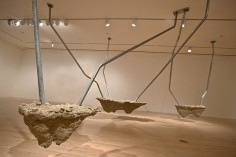RUBEN OCHOA
source: artsynet
Whether sculpture, photography, site-specific installation, or public intervention, Ruben Ochoa’s work is a manifestation of the urban environment he is surrounded by in the Southern California landscape, where he was born and raised. Using vernacular building materials collected from hardware stores, construction sites, and family businesses—even employing the labor skills of relatives for production—Ochoa recalls the concrete, dirt, and rebar of his Los Angeles landscape with a sophisticated-yet-playful elegance. In exploring the geography and physicality of the city, Ochoa addresses the boundaries of the space—curbs, freeways, chain-link fences—all marks of contention, displacement, and division of social classes, which ultimately speak to the social and economic climate of the city.
.
.
.
.
.
.
.
source: pinchukartcentreorg
Ruben Ochoa was born 1974 in Oceanside, California. He studied at the Parsons School of Art and Design, New York, the Otis College of Art and Design, Los Angeles (BFA, 1997), and the University of California, Irvine (MFA, 2003). He currently lives and works in Los Angeles. Ochoa was included in the 2004 California Biennial at the Orange County Museum of Art, Newport Beach, and the 2008 Whitney Biennial at the Whitney Museum of American Art, New York. In 2005 he was awarded a Creative Capital Grant for his Fwy Wall Extraction project and in 2008 he was recipient of a John Simon Guggenheim Memorial Foundation Fellowship.
Ruben Ochoa’s monumental sculptural interventions inside the gallery thematize the disruption of space. They entangle the viewer, dealing with the social, political and ecological dimensions of construction and urban development, through the use of rough construction materials such as metal, concrete and wood. Ochoa recontextualizes and deconstructs “ready-made materials” to invent a sculptural language with strong architectural awareness. His work continuously shows an involvement in the tension between natural landscape and built environment.
Combining new drawings with two new monumental sculptural works, Ochoa creates a special work group, radically disrupting the spaces of PAC.


